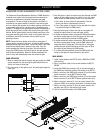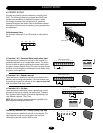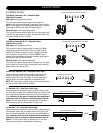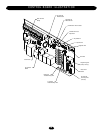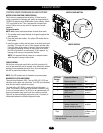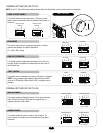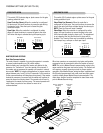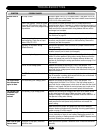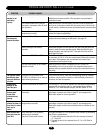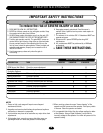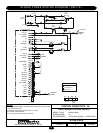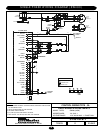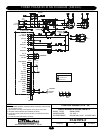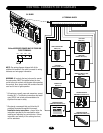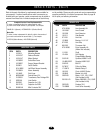
Operator fails to
run.
No Stop Control. Check the green LED (D17) on control board. If the green LED is off,
check to make sure a stop control has been installed across terminals
J1-3 & J1-5 of the control board.
Fault in the operator. Check the yellow
diagnostic LED at the top right of the
control board next to the programming
dip switches.
If the yellow LED blinks six times there is a master/second unit
communication failure. If operator is a single unit make sure there is a
jumper across J4 pins 1 & 2. If operator is in a dual gate configuration
make sure that the communication wiring between the two units is
undamaged and complete.
If the yellow light is solid the board needs to learn the motor. Follow
the directions on page 24.
An accessory is active or
malfunctioning. Check the red input
status LEDs, D11-D31.
If any red LEDs are on, check the corresponding input. An installed
accessory may be wired incorrectly or malfunctioning. Remove the
accessory and test the operator.
Improper J4 Connector Wiring
(Master/Second).
Stand-alone Operators: make sure there is a jumper installed across
the J4 connector.
Master/Second Operation: Make sure that the master/second wiring is
installed correctly and is intact (not damaged).
Low or no high voltage power. Measure the incoming voltage at the unit’s on/off switch. It should be
within 5% of the operator’s rating when running. Make sure that the
proper wire gauge was used for the distance between breaker and
operator by consulting the wiring specifications section on page 14 of
this manual.
Low or no low voltage power. Measure the voltage at terminals R1 & R2 in the operator. This
voltage should be within 5% of 24 Vac. If the high voltage power is
good and the low voltage power is bad, check transformer wiring and
replace transformer.
No LEDs illuminated on the control
board.
If both primary and secondary power is good, check to make sure that
the J2 connector is making good contact with the pins on the board. If
all is good, replace the control board.
The relays chatter
when the operator
begins to move.
Low secondary (low voltage) power. Measure the voltage at terminals R1 & R2 in the operator. This
voltage should be within 5% of 24 Vac. If the high voltage power is
good and the low voltage power is bad, check to make sure the circuit
breaker is not tripped and that the correct primary tap is used on the
transformer. If breaker and tap are correct replace the transformer.
The operator runs
slow and/or trips
the internal
overload.
Low primary (high voltage) power. Measure the incoming line voltage at the unit’s on/off switch as well
as the meter base or sub panel. Make sure there is not a major
change in voltage. The voltage at the operator should be within 5% of
the operator’s rating when running.
Check the number of amps currently being drawn from the panel,
make sure that the total power being drawn does not exceed the
panel’s rating.
Make sure that the proper wire gauge was used for the distance
between breaker and operator by consulting the wiring specifications
section on page 15 of this manual.
Problem in the motor. Perform a visual inspection of the motor. Examine the motor’s labels
for any distortion or signs of over heating. Replace the motor if it is
humming, grinding or making excessive noise. NOTE: Repeated motor
problems indicate poor primary power.
Motor runs but gate
does not move.
Damaged or improperly tensioned
belt/drive chain.
Make sure that the operator’s belt/drive chain is intact and tensioned
correctly.
TROUBLESHOOTING
28
SYMPTOM POSSIBLE CAUSES SOLUTION



